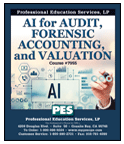Loading

AI for Audit, Forensic Accounting, and Valuation
AI is set to make dramatic changes to accounting and auditing professions, yet existing AI tends to solve very narrow business issues. Accounting and auditing firms need a comprehensive framework for intelligent, automation-centric modernization. This course explains how AI can be effectively integrated within audit management, leading to better automated models and forensic accounting. With this course, you will learn to build an innovative, automated accounting strategy, using AI as the cornerstone and foundation. At the completion, you'll be able to conceptualize how you can evolve utilizing firmwide AI capabilities. PLEASE NOTE: Not accepted for Enrolled Agents. All course material provided. No prerequisites. Course level: Basic.
Course Information
Table of Contents
- PART I: FOUNDATIONS FOR AI AND AUDIT
- Introduction: Staying Ahead of the Emergent Risk
- Fourth Industrial Revolution and Its Impact on Audit
- What is Artificial Intelligence
- Rise of Machine Learning
- Machine Learning
- Building an IAA Audit Firm: The Planning Toolkit
- PART II: BUILDING THE AUTOMATED AUDIT FUNCTION IN THE ENTERPRISE
- Obtain, Retain, and Preplan with AI
- Automated Inherent Risk Assessment
- Automating Internal Controls Assessment
- Automated Procedures
- Reporting and Post-Audit Management
- PART III: FORENSIC ACCOUNTING AUTOMATION
- Intelligent Automation of Fraud Detection
- Forensic Accounting
- Managing for Value and Valuation
- Tying it Together with Robots
- PART IV: MANAGEMENT, ORGANIZATION, AND GOVERNANCE FOR AI IN AUDIT
- Client Management
- AI Organization and Project Management
- Governance and Ethics
Objectives
- To identify the circumstances necessary in order for General Adoption of technology to occur
- To recall the two sources of competitive advantage associated with the Fourth Industrial Revolution
- To recognize common misconceptions regarding AI
- To identify machine learning concepts
- To recall the various methods of supervised and unsupervised machine learning
- To recall the degrees of planning created by the American Institute of Artificial Intelligence
- To recall the characteristics of Deceptive Impression Management (DIM)
- To recognize the types of risk involved when discussing total audit risk
- To identify the four principles of risk assessment as defined by the COSO 2013 framework
- To recognize the standard tools of audit inquiries
- To identify the characteristics of the maturity models for audit firms
- To recall the three classifications of internal fraud as defined by the Association of Certified Fraud Examiners (ACFE)
- To recall the characteristics of financial fraud
- To recognize the various methods used to evaluate technology
- To recall the various parts of robots and their uses
- To recall the characteristics of Enterprise Resource Planning (ERP) systems
- To identify the seven steps of AI project leadership
- To recall the potential impacts of AI on humanity
PLEASE NOTE: CPE credit measurement is based on NASBA Registry and QAS guidelines of one credit for every 50 minutes. Credit calculation may vary in different states — check with your State Board of Accountancy. Unless otherwise noted in the specific course description, no advanced preparation is required in order to register or complete any PES CPE course. Use of materials or services provided by Professional Education Services, LP ("PES") are governed by the Terms and Conditions stated on PES' website www.mypescpe.com. PES provides these courses with the understanding that it is not providing any accounting, legal, or other professional advice and assumes no liability whatsoever in connection with its use. PES has used diligent efforts to provide quality information and material to its customers, but does not warrant or guarantee the accuracy, timeliness, completeness, or currency of the information contained herein. Ultimately, the responsibility to comply with applicable legal requirements falls solely upon the individual licensee, not PES. PES encourages you to contact your state Board for the latest information and to confirm or clarify any questions or concerns you have regarding your duties or obligations as a licensed professional.





